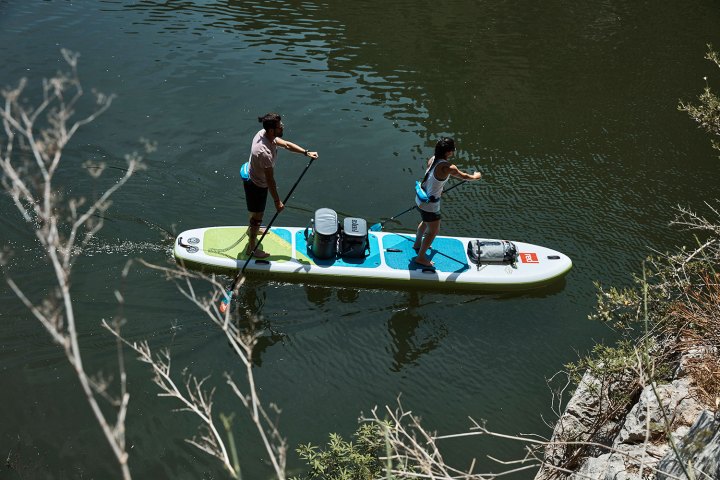
With an extensive and eclectic selection of boards already to its name, the brand recently announced a brand new behemoth of a board, dubbed the Red Paddle Tandem 15-foot Voyager. Though it doesn’t release until mid-October, we recently pumped one up to give this beast a proper run for its money, allowing us to judge whether it’s worth the expected $2,000 price tag. Though, after getting into the water with it, we like so many of its features that it’s hard to even know where to begin — it was that impressive.
We’ll start with the obvious and one of the hallmarks that sets Red Paddle apart from the competition: The board’s phenomenal stiffness.

Historically, the problem with inflatable stand-up paddleboards, compared to their hard shell counterparts, is that they’re difficult to keep stiff. Most are built by drop-stitching a top and bottom sheet together, coating the thread with molten PVC, and affixing an outer layer to the glue for extra reinforcement. This is fantastic when the board comes out of the factory but over time, as the stitching begins to pull and separate, the board tends to get droopy.
The MSL Fusion system difference
Not so with the Red Paddle Tandem, which is made with the company’s proprietary MSL (monocoque structural laminate) Fusion system. This process removes the glue-only layer, substituting it with an adhesive that acts as both a seal and a bonding layer. A machine then laminates a layer of high-density structural PVC around the threads, leaving a board that’s remarkably lighter and stiffer at lower pressures.
State-of-the-art engineering allows riders to pump it up to higher pressures without it popping.
On top of the ability to make the board stay rigid with less air, this state-of-the-art engineering also allows riders to pump it up to higher pressures without it popping. While most boards on the market stop around 18 PSI, for instance, the Tandem inflates up to 25 PSI.
If all of that stiffening technology wasn’t enough, the company also added side battens to the new two-person board for good measure. These are essentially long rods that fit into individually-laminated pockets on the perimeter. The technology, called RSS (Rocker Stiffening System), makes the board up to 40 percent stiffer than normal — depending on paddler weight and how much it’s inflated.
Smooth rider
The end result of this combined technology is a mega-stiff board that glides over water with ease and responds exactly how you want it to. In fact, we tested the board on whitewater and it tracked beautifully throughout, soaring over wave trains and punching through small holes, offering us a smooth surface to clamber back onto when we flipped over.
Another feature that makes this board so spectacular is its roomy, 34-inch deck which offers two sets of bungee cords for rigging gear along with plenty of surface area to comfortably fit two people — and perhaps even a tiny third person or dog. Both bungee sets feature solid D rings to tie everything down, in addition to the seven handles around the perimeter which allowed us to easily carry the board or attach additional gear. The two deck pads situated next to the carry handles essentially doubled as “hold on” straps for non-paddlers.
A Titan of a pump
Then there’s the exceptional ease of pumping. We noticed a number of elements factoring into this, the first being the two included pumps — a regular pump and the company’s deluxe Titan double-chamber pump. The Titan is comprised of two chambers with the larger able to blast 61 miles per hour of air into the board. We used this one when we first started to get as much air into it as possible.
Then, when our arms began feeling sore and it started getting tough to pump, we removed a small gear to shift chambers and the pump dropped down to 21 miles per hour. This tops the board off and allowed us to get a few extra PSIs pumped in. Best of all, with a pair of separate inflation valves, two people would be able to pump at the same time.
The Tandem — releasing Oct. 16 — comes packed in Red Paddle’s all-terrain backpack with both pumps, a repair kit, cell phone case, and removable US Box fin included. Whether you’re planning daytime explorations, short overnighters, or multi-day touring trips, the $2,000 Tandem is a solid value for paddlers seeking the convenience of a packable, inflatable board with the performance standards of a regular hard shell.



